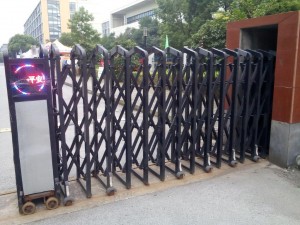China strikes me as a country that is obsessed with security. Or, to be more precise, it is a country obsessed with the perception of security. Properties are always fenced. In Suzhou, the fences are sometimes organic – neatly trimmed hedges of crimson and emerald foliage – but they still serve the purpose of preventing access. Most residence complexes will have only one access point through a mechanized gate that can be opened or closed by remote control. Car parks are surrounded by concrete bollards, with access only through a single point controlled by an arm that must be raised.
Public buildings will usually have many doors leading in and out, but these doors are often locked. And they will usually be locked from both the inside and outside. This can be quite frustrating. As I was exploring my campus during my first week here, I would consult my map and confidently believe that I could get to the building I wanted by simply exiting through a certain door of the building I was currently in. However, that door would be locked, so I would have backtrack to the main entrance and walk the long way around the outside of the building. Shortcuts rarely work here.
The purpose of always funneling traffic back to the main entrance seems to be to provide a justification for the employment of an army of security guards. These guards are everywhere: public buildings, private residence compounds, shopping malls, office towers. Their job description seems to consist of a single task: standing still. They do this very well. Sometimes they will talk to other security guards, but often they are motionless and silent. They sit at desks, looking bored. They stand at attention at sentry posts. They salute cars entering car parks. But they rarely ever stop anyone from actually entering. Their function seems to be that of a visual deterrent. They aren’t particularly threatening in appearance. They are just there, all the time.
A security feature more unique to Suzhou is the system of canals. The city is crisscrossed by these manmade, drainage channels that flow with lazy, milky-green streams. Their purpose may be drainage, but they also serve to restrict movement. Unless you can find a bridge, there is no way across them. Again, one’s intention to take a shortcut will always be frustrated. Even if you were foolish enough to try swimming across, you probably couldn’t get down the bank, as many of the canals are lined with thick rows of majestic willows, whose branches bend and weep into the placid water, silent sentinels that serve both beauty and utility.
I don’t know enough historical or cultural contexts to explain the need for all the visible security here. I don’t have any data to prove whether it is effective or not at actually making the environment safer. I do know, however, that one gets used to it quickly. The security guards are becoming invisible to me. The willows, however, never disappear.
